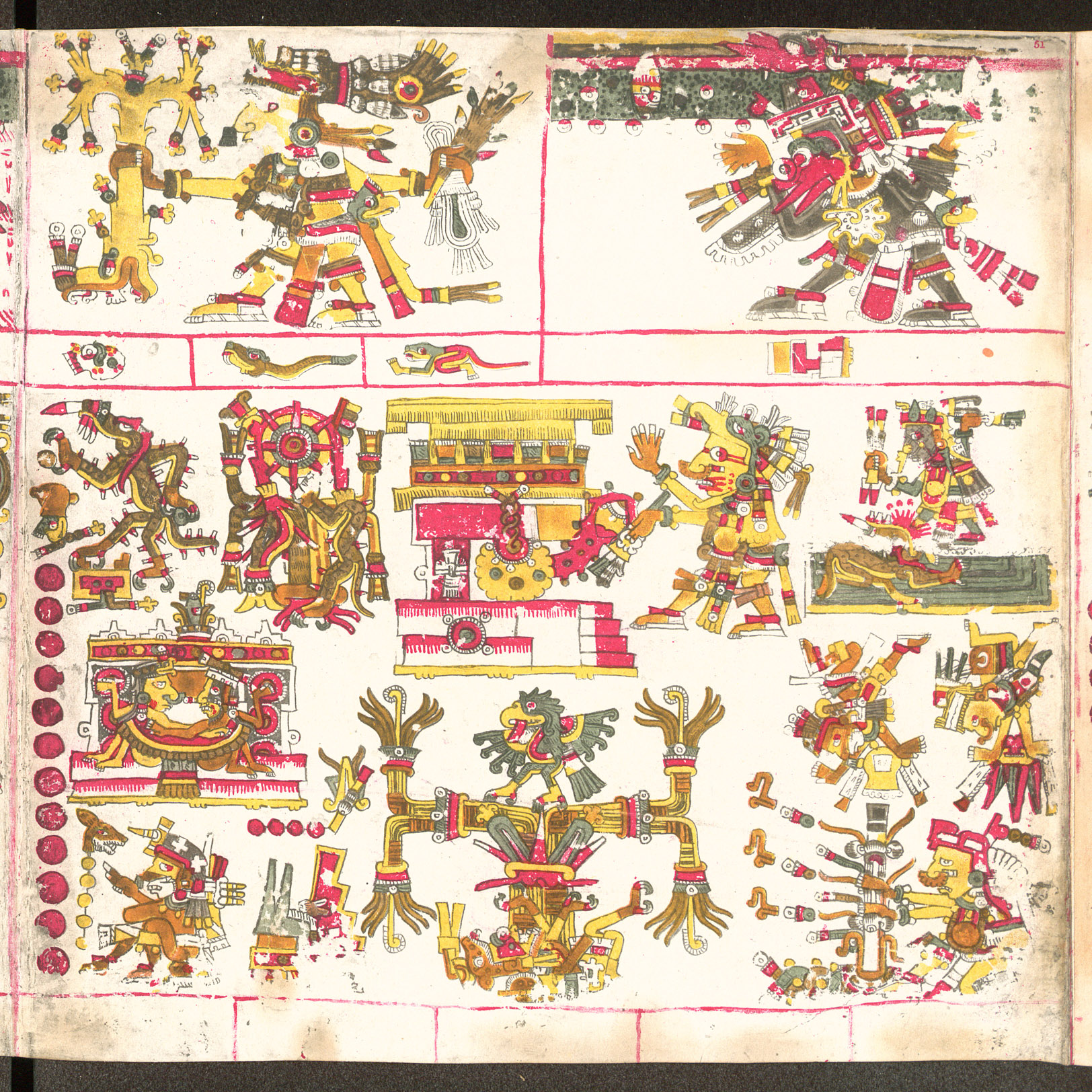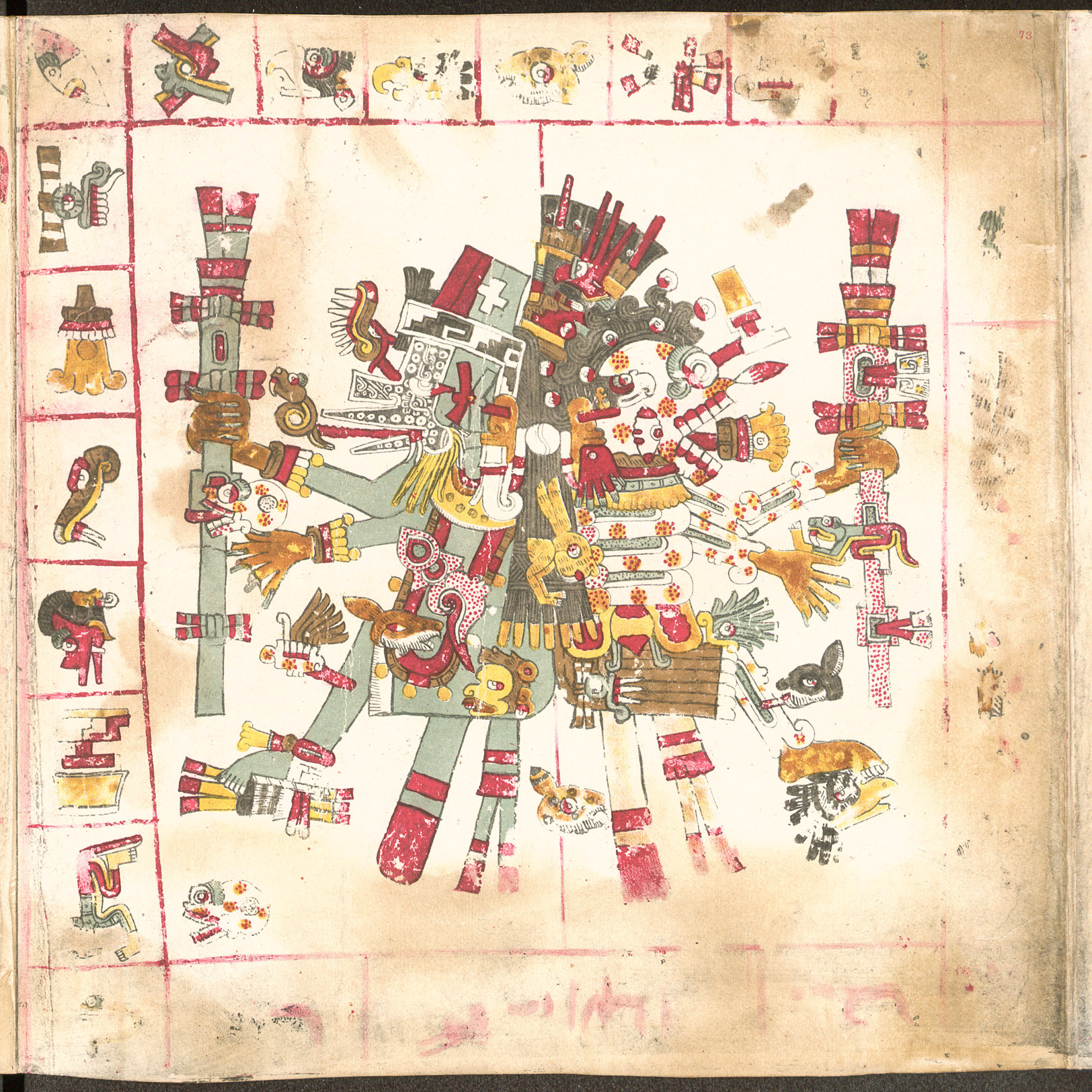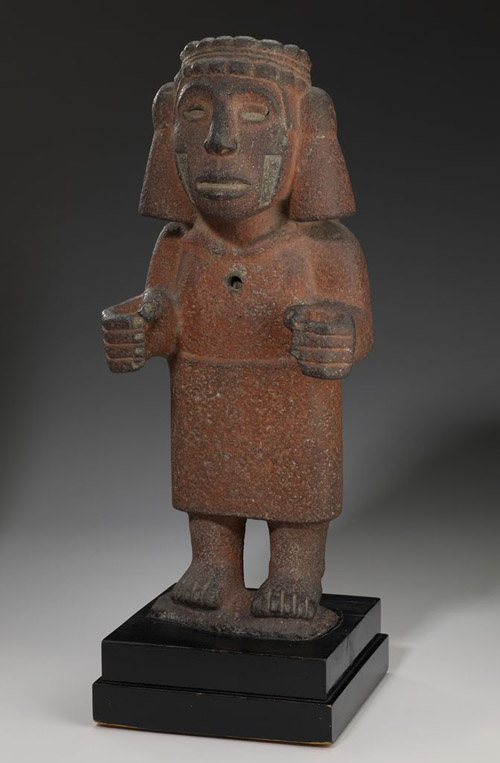|
Xiuhtecuhtli
In Aztec mythology, Xiuhtecuhtli ("Turquoise Lord" or "Lord of Fire"), was the god of fire, day and heat. In historical sources he is called by many names, which reflect his varied aspects and dwellings in the three parts of the cosmos. He was the lord of volcanoes, the personification of life after death, warmth in cold (fire), light in darkness and food during famine. He was also named Cuezaltzin ("flame") and Ixcozauhqui , and is sometimes considered to be the same as Huehueteotl ("Old God"), although Xiuhtecuhtli is usually shown as a young deity.Matos Moctezuma & Solis Olguín 2002, p.476. His wife was Chalchiuhtlicue. Xiuhtecuhtli is sometimes considered to be a manifestation of Ometecuhtli, the Lord of Duality, and according to the Florentine Codex Xiuhtecuhtli was considered to be the father of the Gods, who dwelled in the turquoise enclosure in the center of earth.Matos Moctezuma 1988, p.94. Xiuhtecuhtli-Huehueteotl was one of the oldest and most revered of the indige ... [...More Info...] [...Related Items...] OR: [Wikipedia] [Google] [Baidu] |
Aztec
The Aztecs () were a Mesoamerican culture that flourished in central Mexico in the post-classic period from 1300 to 1521. The Aztec people included different ethnic groups of central Mexico, particularly those groups who spoke the Nahuatl language and who dominated large parts of Mesoamerica from the 14th to the 16th centuries. Aztec culture was organized into city-states ('' altepetl''), some of which joined to form alliances, political confederations, or empires. The Aztec Empire was a confederation of three city-states established in 1427: Tenochtitlan, city-state of the Mexica or Tenochca; Texcoco; and Tlacopan, previously part of the Tepanec empire, whose dominant power was Azcapotzalco. Although the term Aztecs is often narrowly restricted to the Mexica of Tenochtitlan, it is also broadly used to refer to Nahua polities or peoples of central Mexico in the prehispanic era, as well as the Spanish colonial era (1521–1821). The definitions of Aztec and Aztecs ha ... [...More Info...] [...Related Items...] OR: [Wikipedia] [Google] [Baidu] |
Aztec Mythology
Aztec mythology is the body or collection of myths of the Aztec civilization of Central Mexico. The Aztecs were Nahuatl-speaking groups living in central Mexico and much of their mythology is similar to that of other Mesoamerican cultures. According to legend, the various groups who were to become the Aztecs arrived from the north into the Anahuac valley around Lake Texcoco. The location of this valley and lake of destination is clear – it is the heart of modern Mexico City – but little can be known with certainty about the origin of the Aztec. There are different accounts of their origin. In the myth the ancestors of the Mexica/Aztec came from a place in the north called Aztlan, the last of seven ''nahuatlacas'' (Nahuatl-speaking tribes, from ''tlaca'', "man") to make the journey southward, hence their name "Azteca." Other accounts cite their origin in Chicomoztoc, "the place of the seven caves," or at Tamoanchan (the legendary origin of all civilizations). The Mex ... [...More Info...] [...Related Items...] OR: [Wikipedia] [Google] [Baidu] |
Huehueteotl
Huehueteotl ( ; ) is an aged Mesoamerican deity figuring in the pantheons of pre-Columbian cultures, particularly in Aztec mythology and others of the Central Mexico region. The spellings Huehuetéotl and Ueueteotl are also used. Although known mostly in the cultures of that region, images and iconography depicting Huehueteotl have been found at other archaeological sites across Mesoamerica, such as in the Gulf region, western Mexico, Protoclassic-era sites in the Guatemalan highlands such as Kaminaljuyú and Late-Postclassic sites on the northern Yucatán Peninsula (Miller and Taube, 1993:189). The name Huehueteotl stems from Nahuatl ''huēhueh'' ("old") and ''teōtl'' ("god"). It seems to connect the Old God to certain Mayan deities called '' Mam'' ("Grandfather"). Huehueteotl is frequently considered to overlap with, or be another aspect of, a central Mexican/Aztec deity associated with fire, Xiuhtecuhtli. In particular the Florentine Codex identifies Huehueteotl as an al ... [...More Info...] [...Related Items...] OR: [Wikipedia] [Google] [Baidu] |
Lords Of The Night
In Mesoamerican mythology the Lords of the Night ( nci, Yoalteuctin) are a set of nine gods who each ruled over every ninth night forming a calendrical cycle. Each lord was associated with a particular fortune, bad or good, that was an omen for the night that they ruled over. The lords of the night are known in both the Aztec and Maya calendar, although the specific names of the Maya Night Lords are unknown. The glyphs corresponding to the night gods are known and Mayanists identify them with labels G1 to G9, the G series. Generally, these glyphs are frequently used with a fixed glyph coined F. The only Mayan light lord that has been identified is the God G9, Pauahtun the Aged Quadripartite God. The existence of a 9 nights cycle in Mesoamerican calendrics was first discovered in 1904 by Eduard Seler. The Aztec names of the Deities are known because their names are glossed in the Codex Telleriano-Remensis and Codex Tudela. Seler argued that the 9 lords each corresponded to one ... [...More Info...] [...Related Items...] OR: [Wikipedia] [Google] [Baidu] |
Turquoise
Turquoise is an opaque, blue-to-green mineral that is a hydrated phosphate of copper and aluminium, with the chemical formula . It is rare and valuable in finer grades and has been prized as a gemstone and ornamental stone for thousands of years owing to its unique hue. Like most other opaque gems, turquoise has been devalued by the introduction of treatments, imitations and synthetics into the market. The robin's egg blue or sky blue color of the Persian turquoise mined near the modern city of Nishapur in Iran has been used as a guiding reference for evaluating turquoise quality. Names The word ''turquoise'' dates to the 17th century and is derived from the French ''turquois'' meaning "Turkish" because the mineral was first brought to Europe through the Ottoman Empire.Turquoise . minerals.usgs.gov Howe ... [...More Info...] [...Related Items...] OR: [Wikipedia] [Google] [Baidu] |
Thirteen Heavens
The Nahua people such as the Aztec mythology, Aztecs, Chichimecs and the Toltecs believed that the heavens were constructed and separated into 13 levels, usually called Topan or simply each one Ilhuicatl iohhui, Ilhuicatl iohtlatoquiliz. Each level had from one to many Lords (gods) living in and ruling them. Aztec mythology In Aztec mythology, the Thirteen Heavens were formed out of Cipactli's head when the gods made creation out of its body, whereas :es:Tlaltícpac, Tlaltícpac, the earth, was made from its center and the nine levels of the underworld (Mictlan) from its tail. The most important of these heavens was Omeyocan (Place of Two), where Ometeotl - the dual Lord/Lady, creator of the Dual-Genesis who, as male, takes the name Ometecuhtli (Two Lord), and as female is named Omecihuatl (Two Lady) - resided. References Bibliography See also * Aztec mythology * Aztec philosophy * List of Aztec gods and supernatural beings {{DEFAULTSORT:Aztec Mythology ... [...More Info...] [...Related Items...] OR: [Wikipedia] [Google] [Baidu] |
Tezcatlipocas
In Aztec mythology, Creator-gods are the only four Tezcatlipocas, the children of the creator couple Ometecuhtli and Omecihuatl "Lord and Lady of Duality", "Lord and Lady of the Near and the Close", "Father and Mother of the Gods", "Father and Mother of us all", who received the gift of the ability to create other living beings without childbearing. They reside atop a mythical thirteenth heaven Ilhuicatl- Omeyocan "the place of duality". Each of the four sons takes a turn as Sun, these suns are the sun of earth, the sun of air, the sun of fire, the sun of water ( Tlaloc, rain god replaces Xipe-Totec). Each world is destroyed. The present era, the Fifth Sun is ushered in when a lowly god, Nanahuatzin sacrifices himself in fire and becomes Tonatiuh, the Fifth Sun. In his new position of power he refuses to go into motion until the gods make sacrifice to him. In an elaborate ceremony, Quetzalcoatl cuts the hearts out of each of the gods and offers it to Tonatiuh (and the m ... [...More Info...] [...Related Items...] OR: [Wikipedia] [Google] [Baidu] |
Trecena
A trecena is a 13-day period used in pre-Columbian Mesoamerican calendars. The 260-day calendar (the '' tonalpohualli'') was divided into 20 trecenas. Trecena is derived from the Spanish chroniclers and translates to "a group of thirteen" in the same way that a dozen (or in Spanish ''docena'') relates to the number twelve. It is associated with the Aztecs, but is called different names in the calendars of the Maya, Zapotec, Mixtec, and others of the region. Many surviving Mesoamerican codices, such as Codex Borbonicus, are divinatory calendars, based on the 260-day year, with each page representing one trecena. See also * Aztec calendar * Maya calendar The Maya calendar is a system of calendars used in pre-Columbian Mesoamerica and in many modern communities in the Guatemalan highlands, Veracruz, Oaxaca and Chiapas, Mexico. The essentials of the Maya calendar are based upon a system which had ... * Tonalpohualli * K'atun Mesoamerican calendars {{Mesoamerica- ... [...More Info...] [...Related Items...] OR: [Wikipedia] [Google] [Baidu] |
Chalchiuhtlicue
Chalchiuhtlicue (from ''chālchihuitl'' "jade" and ''cuēitl'' "skirt") (also spelled Chalciuhtlicue, Chalchiuhcueye, or Chalcihuitlicue) ("She of the Jade Skirt") is an Aztec deity of water, rivers, seas, streams, storms, and baptism. Chalchiuhtlicue is associated with fertility, and she is the patroness of childbirth. Chalchiuhtlicue was highly revered in Aztec culture at the time of the Spanish conquest, and she was an important deity figure in the Postclassic Aztec realm of central Mexico. Chalchiuhtlicue belongs to a larger group of Aztec rain gods, and she is closely related to another Aztec water god called Chalchiuhtlatonal. Religious significance Chalchiuitlicue directly translates to "Jade her skirt"; however, her name is most commonly interpreted as "she of the jade skirt." She was also known as Chalchiuhtlatonac (chalchihu tltla-tona-c) "She who shines like jade" and Matlalcueye "Possessor of the Blue Skirt" by the Tlaxcalans, an indigenous group who inhabited th ... [...More Info...] [...Related Items...] OR: [Wikipedia] [Google] [Baidu] |
Templo Mayor
The (Spanish: Main Temple) was the main temple of the Mexica people in their capital city of Tenochtitlan, which is now Mexico City. Its architectural style belongs to the late Postclassic period of Mesoamerica. The temple was called ' in the Nahuatl language. It was dedicated simultaneously to Huitzilopochtli, god of war, and Tlaloc, god of rain and agriculture, each of which had a shrine at the top of the pyramid with separate staircases. The central spire was devoted to Quetzalcoatl in his form as the wind god, Ehecatl. The Great Temple devoted to Huitzilopochtli and Tlaloc, measuring approximately at its base, dominated the Sacred Precinct. Construction of the first temple began sometime after 1325, and it was rebuilt six times. The temple was destroyed by the Spanish in 1521, and the Mexico City cathedral was built in its place. The Zócalo, or main plaza of Mexico City today, was developed to the southwest of Templo Mayor, which is located in the block between Sem ... [...More Info...] [...Related Items...] OR: [Wikipedia] [Google] [Baidu] |
Cardinal Directions
The four cardinal directions, or cardinal points, are the four main compass directions: north, east, south, and west, commonly denoted by their initials N, E, S, and W respectively. Relative to north, the directions east, south, and west are at 90 degree intervals in the clockwise direction. The ordinal directions (also called the intercardinal directions) are northeast (NE), southeast (SE), southwest (SW), and northwest (NW). The intermediate direction of every set of intercardinal and cardinal direction is called a secondary intercardinal direction. These eight shortest points in the compass rose shown to the right are: # West-northwest (WNW) # North-northwest (NNW) # North-northeast (NNE) # East-northeast (ENE) # East-southeast (ESE) # South-southeast (SSE) # South-southwest (SSW) # West-southwest (WSW) Points between the cardinal directions form the points of the compass. Arbitrary horizontal directions may be indicated by their azimuth angle value. Determination Addi ... [...More Info...] [...Related Items...] OR: [Wikipedia] [Google] [Baidu] |
Pochteca
''Pochteca'' (singular ''pochtecatl'') were professional, long-distance traveling merchants in the Aztec Empire. The trade or commerce was referred to as ''pochtecayotl''. Within the empire, the ''pochteca'' performed three primary duties: market management, international trade, and acting as market intermediaries domestically. They were a small but important class as they not only facilitated commerce, but also communicated vital information across the empire and beyond its borders, and were often employed as spies due to their extensive travel and knowledge of the empire. The ''pochteca'' are the subject of Book 9 of the ''Florentine Codex'' (1576), compiled by Bernardino de Sahagún. Status in Aztec society ''Pochteca'' occupied a high status in Aztec society, below the noble class. They were responsible for providing the materials that the Aztec nobility used to display their wealth, which were often obtained from foreign sources. The ''pochteca'' also acted as agents for the n ... [...More Info...] [...Related Items...] OR: [Wikipedia] [Google] [Baidu] |







